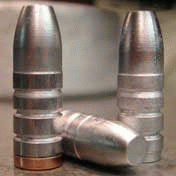

 The Accurate Reloading Forums
The Accurate Reloading Forums  THE ACCURATE RELOADING.COM FORUMS
THE ACCURATE RELOADING.COM FORUMS  Guns, Politics, Gunsmithing & Reloading
Guns, Politics, Gunsmithing & Reloading  Cast Bullets
Cast Bullets  Re: If you're interested..........
Re: If you're interested..........Go  | New  | Find  | Notify  | Tools  | Reply  |  |
| one of us |
Puncher, yes, it appears the two naming conventions we are talking about are the same happening. The latter name is most descriptive of a true explosion which rarely occurs in practice. The SEE description is most appropriate for 99 percent of the wild pressure excursions we most encounter. The difference is in the generation of multiple pressure wave fronts with the SEE condition, whereas in a true explosion/detonation there is only one giant pressure wave. Both condions suggest a reaction which are immediate to us, but, in reality, only the detonation situation is a true immediate happening chemically. A nuclear explosion is not an immediate happening. It is not even a SEE. A nuclear explosion is a very progressive reaction ("burn") and is quite slow in the propagation of a wave front when compared to what we are talking about when using gun powder. In fact, maybe one of our board members can mathematically discover some likelyhood of a nuclear "powder charge" being of value. I'd say offhand, that a bullet will exit the barrel long before any real pressure is built, making the bullet travel no more than several feet. ... felix | ||
|
| one of us |
Yes, indeed, that's a good way to initiate a SEE. The single wave would bounce back off of the projectile, and become additive to another coming foward, should there be one. This would increase the energy of the unburnt powder causing it to go towards a much quicker burn. Should the resulting burn approach the speed of Bullseye, then you would have a destructive SEE. Fortunately, most SEE's are just alarming. Once noticed, that load should NEVER be repeated, even for verification. JUST DON'T DO IT! Unload the rounds, or just pitch them down into a rat hole. ... felix | |||
|
| one of us |
From what I understand, when using reduced loads of slow powder, the powder ignites and the pressure wave has too much space to cover before impinging on the bullet. The bullet then acts like a bore obstruction raising pressures beyond the strength of the steel. The freebore on some rifles can cause this even with a moderate load of slow powder as the bullet starts to move and will stop when entering the rifling just enough for the pressure wave to hit it and cause the bullet to act like an obstruction. The distance the bullet moves in the freebore has the effect of increasing the case capacity. I had a case destroyed in my Swedish Mauser 6.5x55 with 46 grs of 4831. This is listed as a safe load. (all my loads are weighed) No damage to the rifle luckily. I cured it by increasing the powder charge. I then went to Varget with great results. Kind of scary when you have to beat the bolt open and the primer pocket is twice the size it started at. | |||
|
| Powered by Social Strata |
| Please Wait. Your request is being processed... |
|
 The Accurate Reloading Forums
The Accurate Reloading Forums  THE ACCURATE RELOADING.COM FORUMS
THE ACCURATE RELOADING.COM FORUMS  Guns, Politics, Gunsmithing & Reloading
Guns, Politics, Gunsmithing & Reloading  Cast Bullets
Cast Bullets  Re: If you're interested..........
Re: If you're interested..........

Visit our on-line store for AR Memorabilia

